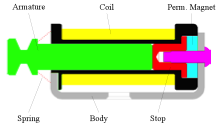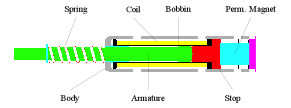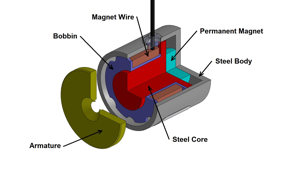The latest entry in the Magnet-Schultz of America Solenoid 101 blog discusses how permanent magnets can be used to accomplish latching functions in solenoids. A more detailed analysis of these types of mechanisms has been previously published by MSA here. This recap will reduce the content to the simplest terms for a quick and clear understanding of the fundamental concepts. Check our blog history for information on more technical subjects and feel free to make suggestions for future posts.
Latching Devices
Solenoids and solenoid driven mechanisms can be used as locks and latches in a number of different ways, but generally when a solenoid is described as “latching” it means that the solenoid has the ability to remain stable at one or both ends of the stroke without power applied through the use of an integrated permanent magnet. Magnet-Schultz of America draws a distinction between the two primary types of latching solenoids. The first category is referred to as “Magnetic Latching Solenoids” and the second category is referred to as “Magnetic Latching Mechanisms”. Another similar product category explained later in the post is the “Permanent Magnet Electromagnet”, which is also capable of remaining latched without power.
Magnetic Latching Solenoids
Magnetic Latching Solenoids are the most commonly referred to type of latching device. These units have a permanent magnet integrated behind the stop. The plunger is retracted by the electromagnetic force of the powered coil and remains seated even after power is shut off due to the permanent magnet. The polarity of the power supplied to the coil during retraction must be complementary to the polarity of the permanent magnet. By sending a pulse of electricity through the coil in the polarity opposite to that of the permanent magnet, the force of the permanent magnet is negated and the spring will extend the plunger. This design allows for reliable and energy efficient operation of medical drawers, cabinets, circuit breakers, and other devices.

Magnetic Latching Solenoid in Retracted Position
Magnetic Latching Mechanisms
Magnetic Latching Mechanisms function similarly to Magnetic Latching Solenoids except that they are designed for high force single cycle operations with a manual reset. These devices have return spring forces that are so high that powering the coil will not create enough electromagnetic force to retract the plunger. The plunger must be fully seated by an external force. Once the plunger is seated, the permanent magnet behind the stop will keep the plunger fully retained without power. When a pulse of power with a polarity inverse to that of the permanent magnet is applied to the coil, the return spring extends the plunger with an extremely high force compared to the size of the unit. These devices are commonly used in fire protection devices and power line interruptors.

Magnetic Latching Mechanism in Retracted Position
Permanent Magnet Electromagnets
Permanent Magnet Electromagnets are a modification of standard holding electromagnets. They hold the armature in place without power applied through the use of a permanent magnet. When power is applied to the coil in a polarity inverse to that of the permanent magnet, the permanent magnet is negated and the armature is released. This effectively reverses the function of an electromagnet, allowing the unit to hold without power and release when pulsed. These devices are used to lock adjustable medical tables in place, hold doors and access hatches, and hold and release ballast.

Permanent Magnet Electromagnet
Magnet-Schultz of America specializes in the custom engineering and manufacturing of solenoids, solenoid valves, electromagnets, voice coils, hydraulic tubes and coils, and locking devices. If you have any questions related to sourcing or manufacturing, please contact us. We will be happy to assist in the development of your application. Browse past blogs for a more in-depth look at solenoid functions and subscribe to the notifications for future posts!







Leave A Comment